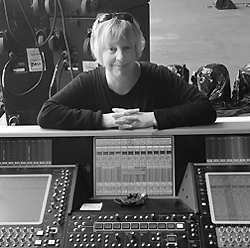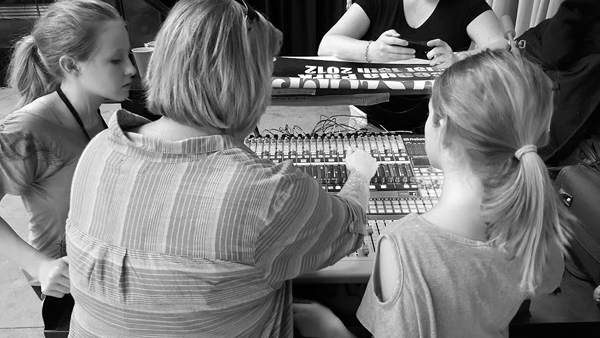
She adds that when engineers try to mix monitors as if practicing their FOH mix, it’s frustrating for the band. “I see that and I’m horrified and they’re like, ‘Well you’re just sitting there doing nothing,’ and I say, ‘Yeah, that means everything is going great.”
When things do go south, she advises: “You can’t take it personally, because then nothing’s going to be solved and everybody will be upset. I think sometimes engineers don’t take into account how stressed the musicians may be about the gig and interpret it as being difficult.
“When you’re starting out, probably the best trait to have is to actually care about the gig and not come off as, ‘I just want to move to FOH.’ You have to be willing to listen. Even if what the musicians are telling you doesn’t make sense you have to figure out what they need and make them comfortable and secure so they can concentrate on performing.”
Even when a touring unit has been together as long as Pearl Jam and their crew – essentially becoming family – Keyes says, issues still crop up that require tact, diplomacy and patience in abundance. That said, the fact that the band’s system has remained relatively consistent over time, helps mitigate those issues.
“They’ve always toured with production and the monitor system doesn’t change much tour to tour, so we’re not starting from scratch and we’re able to focus on what’s working and what isn’t.” That said, “Pearl Jam’s always had volume issues,” she adds. “So the question is always, ‘How are we going make it comfortable for everybody on stage so no one’s losing their sound.”
Different Approaches
As a result, the monitor system has evolved over time. Currently, the band utilizes a mix of in-ear monitors and wedges; specifically Rat S Wedges – which only go out with Pearl Jam – for Vedder, and EAW Microwedges for the other band members.
“About 10 years ago we convinced the band that ears were the way to go and everyone was on ears except our drummer, Matt Cameron, but now IEMs seem to be going by the wayside,” Keyes says. “I would say at this point only our lead guitar player, Mike McCready, relies on ‘ears.’ Everyone else has a combination of wedges and uses either one ear, ears in/out, or ears not on, but could be. At this point there’s two stereo ear mixes, two single/mono ear mixes and then our singer and drummer are not on ears.”
She also cites a recent move to a DiGiCo SD5 from her previous desk as helping to solve roughly 95 percent of the issues they had while also improving workflow and sound quality on stage.
Her approach to monitors with every band she’s worked with is similar: “I just talk to the band and figure out what they need, and I’m fortunate that I’ve been in few situations where I walk into rehearsals without knowing the band.” As examples, she cites RHCP, who she worked with from 1990 to 2000, and Fugazi, which hired her because she mixed their local shows regularly and knew their needs.
“But if I were to do a Fugazi gig tomorrow, I wouldn’t use a Pearl Jam monitor system. It would be minimal,” she notes. “The first tour I did with Fugazi, a few days in they said, ‘The monitors are kind of hard right now.’ And I said, ‘What’s going on? They said, ‘Well, before we had you the monitors sucked. That made us angry and fueled our performance. Now the monitors are fine and there’s nothing making us angry.’
“So I said, ‘Sorry. I could mess them up for you.’ It’s funny what drives bands,” she adds, laughing.
Keyes has enjoyed numerous stand-out moments during her career. Among them mixing monitors for Neil Young on the Mirror Ball Tour and RHCP at Woodstock 3, but she remembers her time with Fugazi particularly fondly. The no-frills approach the group took to production required a lot of work, but owing to their fiery live show and dedication to performance. “There was a magic to it,” she says.
Going & Growing
Keyes’ main gig remains touring with Pearl Jam, and while her passion for mixing is undiminished, it’s matched by her commitment to Soundgirls: “It’s a far-reaching, all-consuming passion.” She and Pettinato launched the organization in 2013 after having met, for the first time, as participants on an AES Conference panel – “Women of Professional Concert Sound” – the year before in San Francisco. “We had a great time in a room with other women, our peers, and I think that was the first time that ever happened for any of us,” she says.
Initially, the founders envisioned Soundgirls “as a place to network and find other women in our jobs,” but since, operating under the sponsorship of The Northern California Women’s Music Festival, it’s grown substantially. For example, one recent initiative is a series of four-day Live Sound Camps for Girls in four different cities in the U.S.
While Keyes believes that women are much more readily accepted in audio and the production industry in general than when she started out, in her view the need for a community like Soundgirls remains important. “I’ve always worked with an amazing group of men who have always been supportive. I’ve never felt I was working with sexist jerks or had to deal with sexual harassment.”
Still, given that women are estimated to make up only about five percent of the workforce in professional audio, the more visibility and resources Soundgirls can provide, the better. “You can’t be something that you never see,” she concludes, bluntly, “and trade magazines can’t feature women every month but we can – so we interview a women each month, publish their stories, and they become role models.”
Based in Toronto, Kevin Young is a freelance music and tech writer, professional musician and composer.

